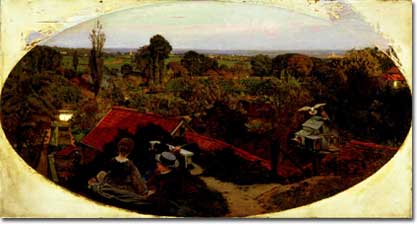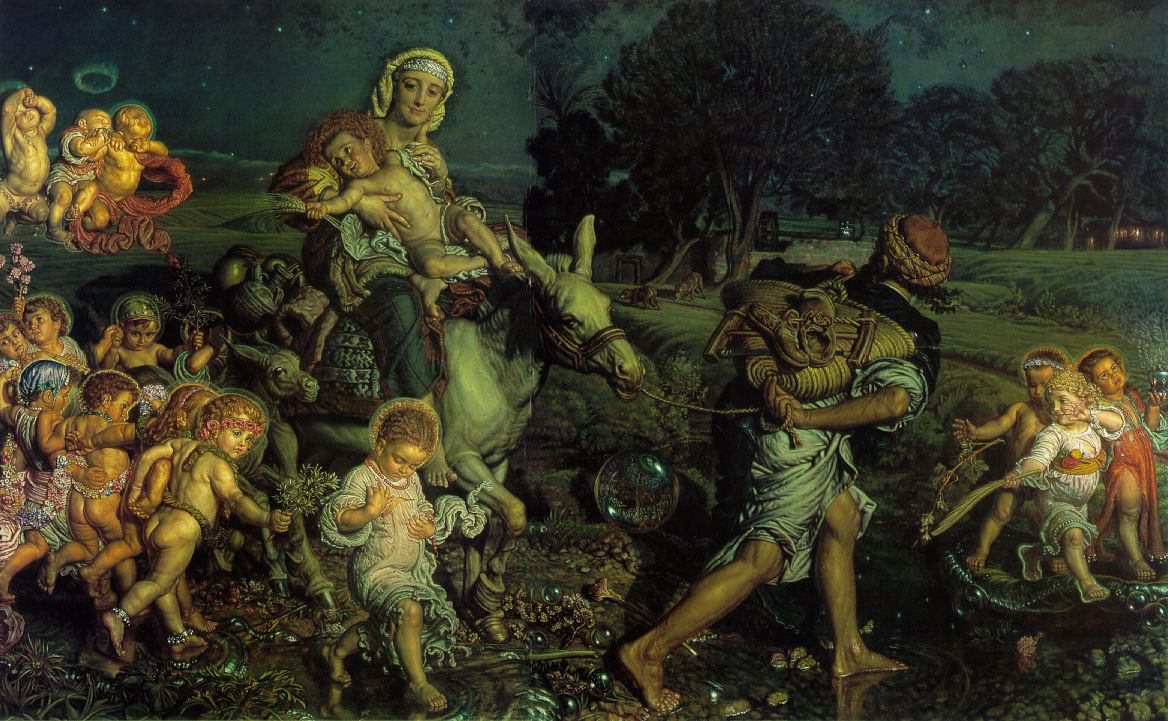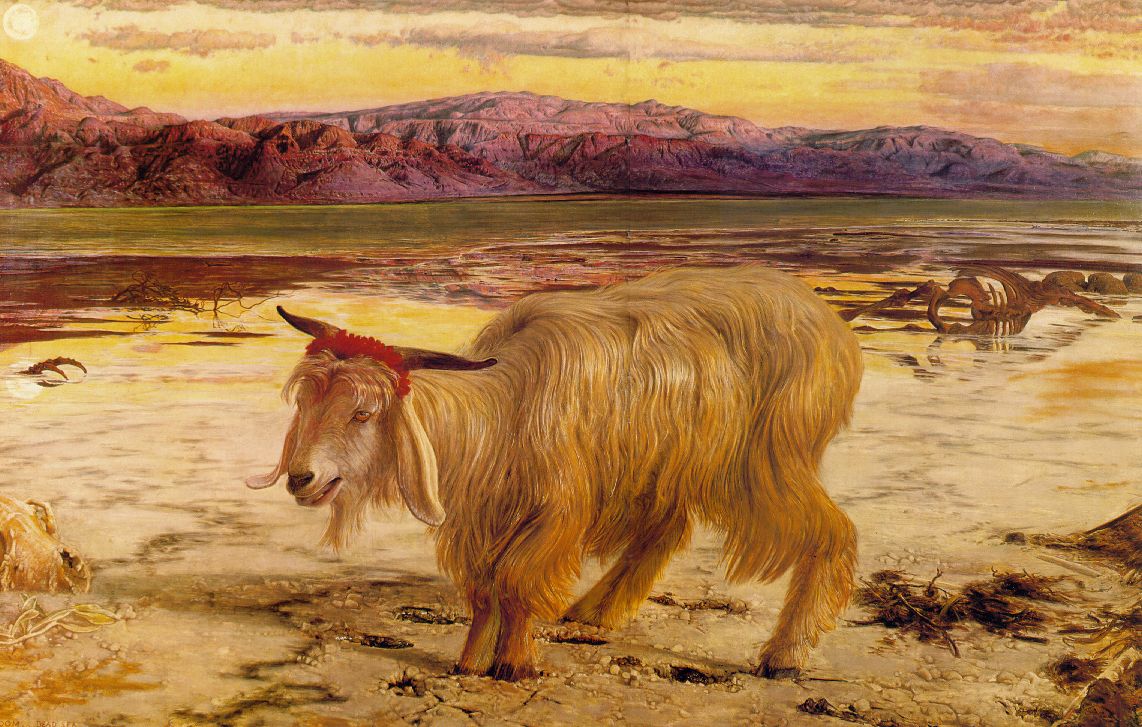Pre-Raphaelite Technique
In the nineteenth century canvases were bought from a colorman and the canvas
was primed with rabbit skin glue generally with a mid-tone that could then be
painted up or down. The PRB bought canvases primed white and they then primed
them again with a new white called zinc white. Zinc white is a colder, more
bluish white than lead (also called flake) white which is yellowish. Then,
according to Hunt, the colour was painted into a wet white layer added on top of
this. This technique is called “wet white” and has become one sign of a PRB
painting. However, it has recently been questioned whether it was ever used
substantially.
Hunt’s Memoirs were written in 1906 and he said he used wet white in the
period 1845-51. Brown did use the technique but he said it was difficult to use
and blamed Hunt for recommending it. Hunt may have used the technique briefly
but there is little evidence form X-ray analysis that it was widely used.
The PRB did however use a bright zinc white primer base onto which they
painted prismatic pigments (i.e. pure pigments). One reason is that by
mid-century there were many more new pigments available. Their favourite colour
was emerald green and green previously had to be mixed. The pigments were mixed
with oil and copal varnish to form a glaze. the also used copal varnish in the
primer to create and even smoother mirror like surface.
As a result a lot of light goes through the pigment and is reflected off the
primer which gives the surface a transparency. If they made a mistake they did
not paint over the area but scraped back to the primer and started again. This
means it is very difficult to see their corrections using X-rays analysis.
With impressionism you can see the brushstrokes and this has been praised as
giving the paintings an honesty (look you can see I am a painting as I am
showing you the brushstrokes) but the PRB brushstrokes are tiny. However, if you
magnify the surface x60 the brushstrokes look very similar to an impressionists
painting in that they are pure unmixed colour. PRB artists saw their painting as
a substitute for vision. When they painted outdoors the white primer must have
been almost luminous in the sun.
See Lindsay Smith (on the book list) to see how the PRB responded to
photography.
Maddox Brown’s An English Afternoon (now in Manchester Art Gallery).
Brown was living over a shop in Hampstead in self-enforced exile as he was
living with a working girl called Emma. This shows the view from his back window
over Hampstead Heath. He painted it over a period 1852-3 and 1855. He had fallen
out with the RA over comments about his Christ so he exhibited it at the
Institute. The painting shows 3.00pm one October afternoon with long shadows and
a glowing light. At the top is London. He said it shows friends not lovers and
the young man is pointing either at London or at the dovecoat (representing
love? he did get married to Emma). The white blob on the left is a fence with a
spade lent against it, a bonfire further away and a white building in the
background that could be Kenwood House (although it is in the wrong place). The
church is St. Annes, consecrated in 1852. In the middle is Hornsey and the tower
on the right is Kentish Town, The Heath was privately owned and the Lord wanted
to sell it. It had been used since the 16thC for London’s water supply and for
ballast for roads. Constable’s views of Hampstead were by campaigners to help to
save the Heath.
The work involved in a PRB painting is appreciated but it tends not be be
thought of as a style (as it is so “photographic”). This is, of course,
completely wrong but academically it is actually breaking new ground to discuss
the PRB style. Of course, we can recognise a PRB painting and each painter has a
different was of working so all the evidence of style is there but English art
historians have not looked at the work of the Pre-Raphaelites in terms of style.
An exception is an article by Robin Ironside that discusses the style but he is
an artist.
Professor Zeki is a scientist who has looked at the way the eye works. For
example, see Inner Vision, An Exploration of Art and the Brain
by Semir Zeki, Oxford University Press, Oxford, UK.
The PRB tend to have a large central human figure such as Ophelia or the
Stonebreaker by Wallis.
A PRB painting has an almost industrial, mass produced look to it. It
certainly appealed to the Victorian work ethic and this gave the PRB a moral
head start.
The PRB were very aware of colour theories of the time (like the
impressionists in Paris and Eug'ne Chevreul). See the book Science and Art by
Martin Kemp and the chapter on 19th century London. At the time George Field, a
colorman who supplied the PRB, was writing on colour.
Hunt, The Triumph of the Innocents, 1883-4. Note the painting of the bubbles
and the colour used.
Hunt, The Scapegoat, 1855-60. See quote in handout and see Carol’s article.
Hunt published keys to his painting with numbered guides.
From his diary we know he painted Scapegoat over a year and that the goat
died. The painting is constructed from individual elements (like a Hockney made
of individual photographs all pasted together). The far mountains seem to be the
same distance as the goat. The goat is disjointed, the head and legs are in the
wrong position for the body. We also know he drew sketches for the work over a
period. This painting took a year, the next six years and the one after 12
years.



